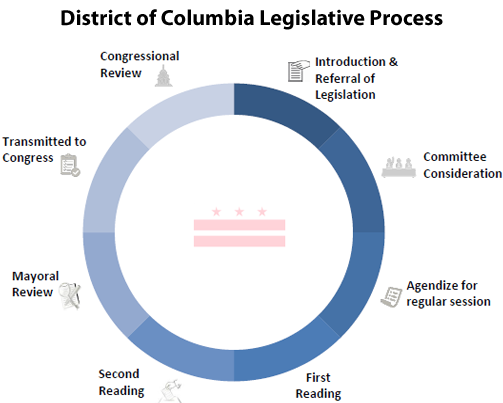How Does a Bill Become a Law?

A bill becomes a law after it is passed by both houses of Congress and signed by the President. If the President vetoes it, Congress can override the veto with a two-thirds vote.
How Does a Bill Become a Law? Understanding the process of how a bill becomes a law is pivotal to comprehending the workings of the United States legislative system. This journey from an idea to enforceable legislation involves several critical steps, including drafting, committee review, and potential amendments.
Each stage is essential in shaping the bill’s final form, which will impact the lives of Americans. Engaging with this process demystifies the complexities of governance and highlights the importance of active civic participation. By grasping the legislative flow, citizens and aspiring policymakers can better appreciate the intricate balance of powers and responsibilities within the U. S. Government.
The Legislative Process
The Legislative Process is a fascinating journey of transformation.
An idea blooms into a law through a series of structured steps.
Each phase plays a critical role in ensuring only the best proposals become laws.
This post will unravel the stages from a bill’s conception to its final passage.
Bills: From Idea To Proposal
The life of a bill begins with a spark of inspiration.
It could come from anyone: a citizen, a group, or a lawmaker.
Once an idea gains momentum, it must find a sponsor in Congress.
This sponsor will turn the idea into a formal document.
Here is the transformation from an idea into a bill proposal:
- An idea is born: A need for change sparks an idea.
- Sponsorship: A member of Congress agrees to introduce the idea.
- Drafting: The bill is written with precise legal language.
- Introduction: The bill is presented to either the House or Senate.
The Role Of Committees
After a bill is introduced, it’s time for detailed examination.
Committees play a pivotal role here.
They scrutinize the bill’s language and implications.
The bill may undergo revisions or additions.
Only the most promising bills advance to the next stage.
| Stage | Action |
|---|---|
| Referral | Bill is assigned to a committee. |
| Hearings | Experts and public provide input. |
| Markup | Committee members debate and amend the bill. |
| Vote | Committee votes on whether to send the bill to the full chamber. |
If the committee votes “yes,” the bill moves forward.
A “no” vote can mean the bill’s journey ends.
Strong backing in a committee is crucial for a bill’s survival.
Credit: techequitycollaborative.org
The House And Senate Floors
Once a bill clears committee hurdles, it heads to the larger stage: The House and Senate Floors. This is where lawmakers from across the country debate its merits. They propose changes, also known as amendments. Each chamber has unique rules guiding this critical phase of a bill’s journey.
Debate And Amendments
Debate is crucial on both House and Senate Floors. Members take turns speaking for or against the bill. They explain why they believe it will help or hurt their constituents.
- Time limits for debate may apply, especially in the House.
- Amendments can change parts of the bill.
- Not all amendments get accepted; they must win a majority vote.
Lawmakers must carefully consider each amendment. The changes they make can greatly impact the bill’s final form.
Voting Procedures
Different voting methods can take place. Votes are often recorded electronically. Sometimes, a roll call vote is needed. In this case, each member’s vote is recorded individually.
| Type of Vote | Description |
|---|---|
| Voice Vote | Members shout ‘aye’ or ‘no’ and the loudest side wins. |
| Division Vote | Members stand to be counted for or against the bill. |
| Electronic Vote | Each member uses an electronic system to record their vote. |
| Roll Call Vote | Each member’s name is called, and they publicly state their vote. |
A bill needs a simple majority to pass. If a bill secures more ‘yes’ votes, it moves forward. In case of a tie, the Speaker of the House or the Vice President in the Senate can cast a deciding vote.
Reconciliation Of Bill Versions
The journey of a bill through the halls of legislation is a complex process. Reconciling bill versions is one of the paramount steps before a bill can see the light of law. It’s here that the different versions of a bill, passed individually by the House and the Senate, are merged into one, cohesive piece of legislation ready for final approval.
Conference Committees
Conference committees play a crucial role in ironing out the differences between House and Senate bill versions. These committees comprise members from both chambers, each bringing their unique perspective to ensure a comprehensive final draft. The result is a compromise that blends the visions of both sides into a unified document.
- Attendees: Select House and Senate members.
- Purpose: To negotiate bill differences.
- Outcome: A polished and unified bill ready for review.
Final Approval
With the conference committee’s version in hand, both the House and Senate must give their final nod of approval. Each chamber will vote on the reconciled bill, seeking a majority to push it through this ultimate legislative checkpoint. Upon success, the bill progresses to the President for signature.
| House | Senate |
|---|---|
| Majority vote needed | Majority vote needed |
| Reflects changes made in committee | Reflects changes made in committee |
| Bill sent to President if passed | Bill sent to President if passed |
The President’s signature is the final step; a stroke of the pen can either make or break a bill’s transformation into law.
The Executive’s Decision
The Executive’s Decision is a critical step in the journey of a bill. Once Congress passes a bill, it does not automatically become law. The President of the United States must weigh in. Without the President’s signature, a bill may never see the light of day as law. This stage is vital and holds two possible paths: approval or rejection.
Presidential Approval Or Veto
Once a bill reaches the Oval Office, the President has a choice. A signature means the bill becomes law. This is cause for celebration for supporters. A veto, on the other hand, sends the bill back to Congress. It’s a message: “Try again or convince me.”
Veto Override Process
If the President vetoes a bill, Congress isn’t out of options. They can override the veto. This doesn’t happen often, but it’s possible. The numbers are important here. Two-thirds of both the House and the Senate must agree. It’s a high bar, signaling strong support for the bill. See below how the two chambers vote:
| Chamber | Vote Needed for Override |
|---|---|
| House of Representatives | Two-thirds majority |
| Senate | Two-thirds majority |
- A successful override means the bill becomes law without the President’s signature.
- If Congress fails, the bill does not advance.
From Law To Implementation
Understanding how a bill becomes law is crucial. After the long journey through Congress, a bill’s real-world impact starts with ‘From Law to Implementation’. Let’s explore what happens after the President’s signature.
Publication And Codification
Once a bill becomes law, officials publish it in the United States Statutes at Large. This is the official record of all the laws.
Next, they sort the new law into the United States Code (U.S.C.). The U.S.C. organizes laws by topics. Lawyers and judges use it to understand legal details.
Here’s how the process works:
- First, the Government Publishing Office prints the law.
- Then, it goes into the Statutes at Large.
- Finally, experts add it to the U.S.C. under the right title and section.
Regulatory And Enforcement Actions
Sometimes, laws need more rules to work right. Federal agencies create these rules. People call these rules regulations.
Agencies start by publishing a proposed rule in the Federal Register. The public can give comments. Agencies review them before making final rules.
| Step | Action | Outcome |
|---|---|---|
| 1 | Propose a rule | Notice in the Federal Register |
| 2 | Collect public feedback | Comments reviewed |
| 3 | Issue final rule | Enforceable regulation |
Once the rules are set, agencies focus on enforcement. They must make sure everyone follows the new law and its rules. This keeps things fair and safe for everyone.
The path from a bill to implementation involves many steps. Each one is key for our laws to work well.

Credit: dccouncil.gov
Conclusion
Understanding the legislative process empowers citizens. Through this journey from proposal to enactment, a bill faces scrutiny and revision. It’s a testament to democracy’s complexities and its capacity to evolve. Let’s stay informed on our system’s workings to foster a vibrant, participatory political culture.
Engage, question, and contribute to the law-making process in your community.
Amelia Justiceberg, a distinguished legal luminary, thrives on the intersection of empathy and legal acumen. As a prominent family law attorney, she orchestrates compassionate resolutions amidst complex dynamics. Justiceberg's courtroom finesse and dedication to fairness define her practice. Beyond litigation, she ardently advocates for social justice, solidifying her reputation as an influential force in the legal landscape.






